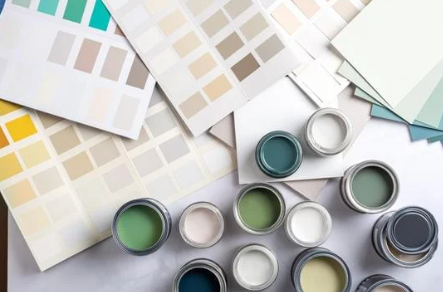5 strategies for choosing paint colors like a designer (and 1 thing NOT to do!)
- Jennifer Janeway

- May 5, 2020
- 4 min read
Hi everyone, and welcome to the first installment of my blog! What a strange time this is! We’ve all been staring at our own walls for months now, and since you’ve made it through the process of finding ways to re-stock your household supplies (which for me includes BoomChickaPop Kettle Corn and these delightful little cashew clusters from Costco), you may find yourself looking for a new project around the house.

We’ve all heard that paint is a fast, inexpensive, and DIY-friendly way to change up your space. But so many people that I’ve talked to say that they have a really hard time choosing the right color. They painted their living room a grey, but it ends up looking baby blue, or they chose what they thought was a trending ‘millennial pink’ for their daughter’s room that ended up looking more like pepto bismol.
Read on for how you can use these methods to choose your next paint color:
1: Do NOT choose color from a chip. I’ll say it again. DO NOT CHOOSE YOUR COLOR FROM A PAINT CHIP! There's no way that it's big enough to be helpful, and you're not going to get a true result.

2. Look at undertones. In order to choose the right color for your space, you’ll need to choose a color with an undertone that complements the things in your home that won’t be changing. Take a moment to look around at the things that aren’t going anywhere – your flooring, your hard finishes like tile and cabinetry, countertops. Neutrals, including whites, have undertones – they may be pink, yellow, blue, violet, orange or green, but they’re definitely there, and they have a huge impact on how that color looks in your home.
Unfortunately, just because you see a color that you love on Pinterest doesn’t mean that it’s going to look the same in your space, depending on your surroundings. Get out your old color wheel, and choose colors with undertones that either complement or contrast your current finishes.

3. Choose cohesive colors. Don't give yourself color whiplash from room to room. Choose a palette that transitions you from room-to-room cohesively. An easy way to do this is to choose colors from the same paint strip - shades of lighter and darker of a given color. Another choice to go with a single color throughout say, a floor or series of adjoining rooms. It may sound boring at first, but you want your home to have a color story that’s cohesive throughout, and makes it feel unified as one space.
4. Buy paint samples or use Samplize. Get yourself some sample colors from your paint supplier of choice. I work with Sherwin Williams, and they have these Color to Go paint samples that you can have mixed to whatever colors you want to try, and then take home and test. At less than $10 each, it's well worth it instead of repainting your room later. When you do paint, make sure that you're painting at least a 12" X 12" area so that you can see how the paint looks in a larger area. (See #5 below.)
Not into the mess of painting? Easy! I just discovered Samplize - for a few dollars a color, you can get actual 12" X 12" painted samples that you can move around your room, and hold against your finishes to get a sense of how the color will look on your walls!

5. Test your colors in multiple places in your home. Have some extra drywall? Test the colors on either a big piece of drywall that you can move around from place to place in your house, or paint a large sample on an existing wall. Make sure that you're comparing the color to your current finishes - next to a brick fireplace, your trim (especially if it's wood!), adjacent rooms, and your furniture. If you're painting directly onto a wall, make sure to do it in a few different places so that you can see how the colors look in different rooms (or places in your room).

6. Study it day and night. Ok, not literally, but look at your test samples at different times in the day, evening and night. Lighting – both natural and the bulbs in your fixtures – can affect the way that color looks in your home. Incandescent bulbs typically bring out warmer tones, while fluorescent or LED bulbs can cast a cooler tone. Big bright southern-facing windows will likely have your color read very true to its shade, while north facing rooms read darker and cooler in tone during the day. These rooms may be the perfect place to experiment with that dark and moody shade you’ve been eyeballing.
Remember, the paint color that you choose sets the tone for your space, and (ideally!) pulls all of the elements of your room together, so choose wisely!
Still confused or overwhelmed? Contact me for a paint consultation! We can do it virtually, or when things get back to normal (whenever that is!) right in your home. Reach out at www.jenniferjanewaydesigns.com/contact today!




Comments